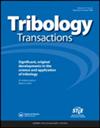不同工况下Mo含量对Fe-Mn-Al-C合金摩擦磨损性能的影响
IF 2.2
3区 工程技术
Q2 ENGINEERING, MECHANICAL
引用次数: 0
摘要
本文章由计算机程序翻译,如有差异,请以英文原文为准。
Effect of Mo content on friction and wear properties of Fe-Mn-Al-C alloys under different working conditions
Abstract For this study, Fe-25Mn-9Al-8Cr-1C-xMo alloys (x = 0, 0.1, 0.2, 0.3, 0.4 wt%) were prepared by mechanical alloying combined with vacuum hot-pressing sintering. The corresponding microstructure, mechanical properties, and friction and wear properties under different working conditions (dry friction, oil lubrication and sulfur-containing boundary lubrication) of materials were studied. The results show that the Fe-25Mn-9Al-8Cr-1C alloy is mainly composed of the austenite phase, Cr7C3 phase, and a small amount of a-Al2O3 phase. After adding Mo element, the Fe2MoC phase appears. With the increase of Mo content, the tensile strength and elongation of the alloys increase first and then decrease. In particular, when the Mo content is 0.3 wt%, an excellent combination of strength and toughness is obtained. The product of strength and elongation of the Fe-25Mn-9Al-8Cr-1C-0.3Mo alloy reaches a maximum value of 3.69 GPa·%, which is improved by 158.04% compared with the matrix alloys. With the increase of Mo content, the average friction coefficient and volume wear rate of the alloys show a trend of first decreasing and then increasing under different working conditions. Also, the average friction coefficient and volume wear rate of the alloy with 0.3 wt% Mo reach a minimum value, especially under the condition of sulfur-containing boundary lubrication. The average friction coefficient and volume wear rate of Fe-25Mn-9Al-8Cr-1C-0.3Mo alloy are 0.051 and 0.222 × 10−4 mm3·N−1·m−1, respectively, which are 40.69% and 46.38% lower than those of the matrix alloys.
求助全文
通过发布文献求助,成功后即可免费获取论文全文。
去求助
来源期刊

Tribology Transactions
工程技术-工程:机械
CiteScore
3.90
自引率
4.80%
发文量
82
审稿时长
4 months
期刊介绍:
Tribology Transactions contains experimental and theoretical papers on friction, wear, lubricants, lubrication, materials, machines and moving components, from the macro- to the nano-scale.
The papers will be of interest to academic, industrial and government researchers and technologists working in many fields, including:
Aerospace, Agriculture & Forest, Appliances, Automotive, Bearings, Biomedical Devices, Condition Monitoring, Engines, Gears, Industrial Engineering, Lubricants, Lubricant Additives, Magnetic Data Storage, Manufacturing, Marine, Materials, MEMs and NEMs, Mining, Power Generation, Metalworking Fluids, Seals, Surface Engineering and Testing and Analysis.
All submitted manuscripts are subject to initial appraisal by the Editor-in-Chief and, if found suitable for further consideration, are submitted for peer review by independent, anonymous expert referees. All peer review in single blind and submission is online via ScholarOne Manuscripts.
 求助内容:
求助内容: 应助结果提醒方式:
应助结果提醒方式:


